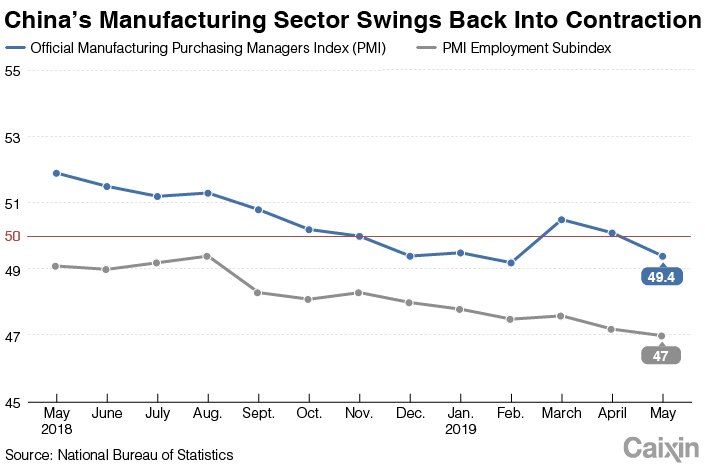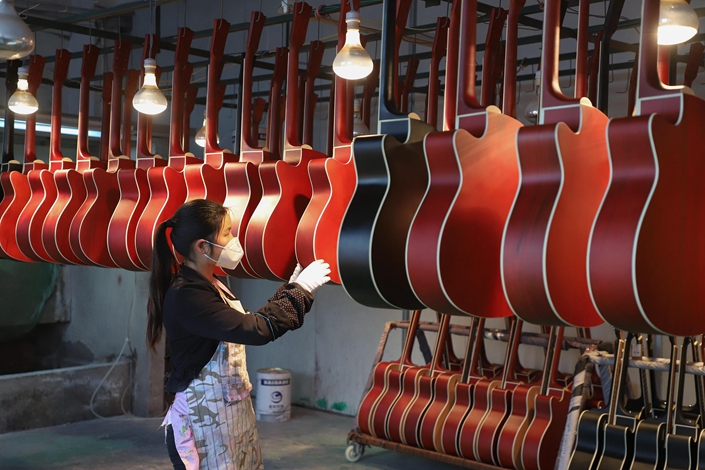Trade War Drags Manufacturing PMI Into Contraction
China’s manufacturing sector swung faster than expected back into contractionary territory in May as export orders fell sharply amid continuing U.S.-China trade war pressure. The sector’s employment gauge was also dragged down to its lowest level since early 2009.
The official purchasing managers index (PMI), a snapshot of operating conditions in the manufacturing sector, dipped to 49.4 in May from 50.1 in April, according to data released Friday by the National Bureau of Statistics (NBS). The reading marks a three-month low and missed the median 49.9 forecast by a Bloomberg survey of economists.
 |
A reading of 50 separates expansion from contraction. The higher the number above 50, the faster the expansion, while the further below 50, the greater the contraction. Manufacturing accounts for 30% of China’s gross domestic product.
Weakening new orders, particularly for exports, were the main drag on the index, amid cooling global demand and increasing trade tensions. After the U.S. announced an increase in tariffs on $200 billion of Chinese goods to 25% from 10% earlier this month, Beijing retaliated by raising levies on U.S. imports of around $60 billion annually, starting June 1.
“Export orders dropped back particularly sharply, which suggests Trump’s latest tariff hike may already be undermining foreign demand,” said Julian Evans-Pritchard, Senior China Economist at Capital Economics.
After a bounce in March, China’s major economic indicators for growth in investment, retail sales and industrial output all fell in April. “Beijing cannot afford to stop easing,” said analysts from Nomura in a note following the PMI release.
 |
Workers fix guitars in Zunyi, Guizhou province, April 10, 2019. Photo: VCG |
The employment subindex of the manufacturing PMI fell to the lowest level since February 2009, NBS data showed. Stabilizing employment as growth cools is now a top priority for the government, said analysts at CEBM Group, a subsidiary of Caixin Insight Group, in a note earlier in May.
China’s non-manufacturing business activity index, which includes the services and construction sectors, remained at 54.3, the same as the previous month, NBS data showed. However, the employment subindex fell to the lowest level since March 2016.
“[S]ome pockets of China’s non-manufacturing sector are still holding up and providing support to the overall growth momentum,” said Betty Wang, Senior China Economist at ANZ Research.
Contact reporter Ke Baili (bailike@caixin.com)

- 1Cover Story: How China Inc. Is Discovering Its New World in Brazil
- 2Offshore Yuan Breaches 7.0 Per Dollar to Hit 15-Month High
- 3In Depth: Memory Shortage Creates Space for China’s Lesser-Known Chipmakers
- 4China Targets AI-Generated Misinformation, Illegal Stock Tips in New Cleanup
- 5Chinese GPU-Maker Moore Threads Unveils AI Chip to Rival Nvidia
- 1Power To The People: Pintec Serves A Booming Consumer Class
- 2Largest hotel group in Europe accepts UnionPay
- 3UnionPay mobile QuickPass debuts in Hong Kong
- 4UnionPay International launches premium catering privilege U Dining Collection
- 5UnionPay International’s U Plan has covered over 1600 stores overseas






